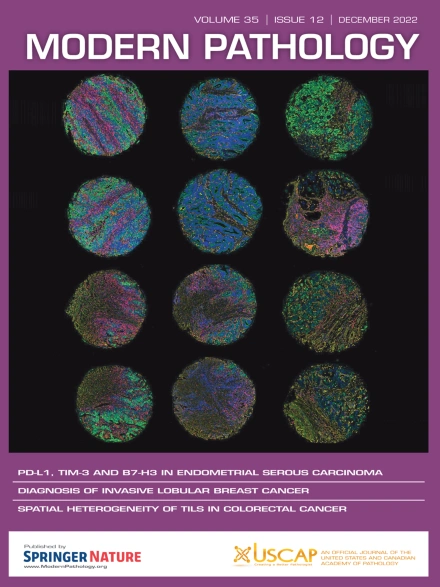Labor-Efficient Pathological Auxiliary Diagnostic Model for Primary and Metastatic Tumor Tissue Detection in Pancreatic Ductal Adenocarcinoma
IF 7.1
1区 医学
Q1 PATHOLOGY
引用次数: 0
Abstract
Accurate histopathological evaluation of pancreatic ductal adenocarcinoma (PDAC), including primary tumor lesions and lymph node metastases, is critical for prognostic evaluation and personalized therapeutic strategies. Distinct from other solid tumors, PDAC presents unique diagnostic challenges owing to its extensive desmoplasia, unclear tumor boundary, and difficulty in differentiating from chronic pancreatitis. These characteristics not only complicate pathological diagnosis but also hinder the acquisition of pixel-level annotations required for training computational pathology models. In this study, we present PANseg, a multiscale weakly supervised deep learning framework for PDAC segmentation, trained and tested on 368 whole-slide images (WSIs) from 208 patients across 2 independent centers. Using only image-level labels (2048 × 2048 pixels), PANseg achieved comparable performance with fully supervised baseline (FSB) across the internal test set 1 (17 patients/58 WSIs; PANseg area under the receiver operating characteristic curve [AUROC]: 0.969 vs FSB AUROC: 0.968), internal test set 2 (40 patients/44 WSIs; PANseg AUROC: 0.991 vs FSB AUROC: 0.980), and external test set (20 patients/20 WSIs; PANseg AUROC: 0.950 vs FSB AUROC: 0.958). Moreover, the model demonstrated considerable generalizability with previously unseen sample types, attaining AUROCs of 0.878 on fresh-frozen specimens (20 patients/20 WSIs) and 0.821 on biopsy sections (20 patients/20 WSIs). In lymph node metastasis detection, PANseg augmented the diagnostic accuracy of 6 pathologists from 0.888 to 0.961, while reducing the average diagnostic time by 32.6% (72.0 vs 48.5 minutes). This study demonstrates that our weakly supervised model can achieve expert-level segmentation performance and substantially reduce annotation burden. The clinical implementation of PANseg holds great potential in enhancing diagnostic precision and workflow efficiency in the routine histopathological assessment of PDAC.
胰腺导管腺癌原发和转移性肿瘤组织检测的高效病理辅助诊断模型。
准确的组织病理学评估胰腺导管腺癌(PDAC),包括原发肿瘤病变和淋巴结转移,对于预后评估和个性化治疗策略至关重要。与其他实体肿瘤不同,PDAC因其广泛的结缔组织增生、肿瘤边界不清、难以与慢性胰腺炎鉴别而具有独特的诊断挑战。这些特征不仅使病理诊断复杂化,而且阻碍了训练计算病理模型所需的像素级注释的获取。在这里,我们提出了PANseg,一个用于PDAC分割的多尺度弱监督深度学习框架,在来自两个独立中心的192名患者的368张全幻灯片图像(wsi)上进行了训练和测试。仅使用图像级标签(2,048×2,048像素),PANseg在内部测试集1(17名患者/58名wsi)中取得了与完全监督基线(FSB)相当的性能;PANseg AUROC: 0.969 vs FSB AUROC: 0.968),内测组2(40例患者/44例wsi;PANseg AUROC: 0.991 vs FSB AUROC: 0.980)和外部测试集(20例患者/20例wsi;PANseg AUROC: 0.950 vs FSB AUROC: 0.958)。此外,该模型对以前未见过的样本类型显示出相当大的普遍性,新鲜冷冻标本(20例患者/20例WSIs)的auroc为0.878,活检切片(20例患者/20例WSIs)的auroc为0.821。在淋巴结转移检测中,PANseg将6名病理医师的诊断准确率从0.888提高到0.961,平均诊断时间缩短32.6% (72.0 vs 48.5分钟)。研究表明,我们的弱监督模型可以达到专家级的分割性能,并大大减少标注负担。PANseg的临床应用在提高PDAC常规组织病理评估的诊断精度和工作流程效率方面具有很大的潜力。
本文章由计算机程序翻译,如有差异,请以英文原文为准。
求助全文
约1分钟内获得全文
求助全文
来源期刊

Modern Pathology
医学-病理学
CiteScore
14.30
自引率
2.70%
发文量
174
审稿时长
18 days
期刊介绍:
Modern Pathology, an international journal under the ownership of The United States & Canadian Academy of Pathology (USCAP), serves as an authoritative platform for publishing top-tier clinical and translational research studies in pathology.
Original manuscripts are the primary focus of Modern Pathology, complemented by impactful editorials, reviews, and practice guidelines covering all facets of precision diagnostics in human pathology. The journal's scope includes advancements in molecular diagnostics and genomic classifications of diseases, breakthroughs in immune-oncology, computational science, applied bioinformatics, and digital pathology.
 求助内容:
求助内容: 应助结果提醒方式:
应助结果提醒方式:


